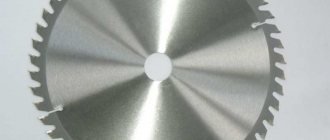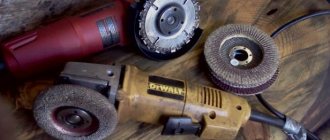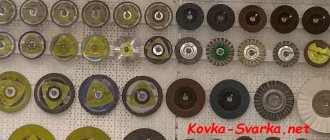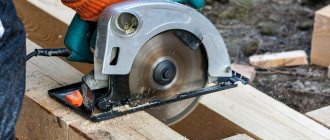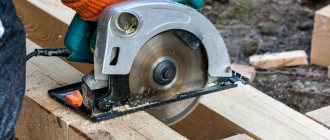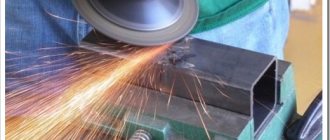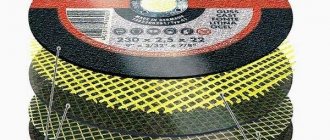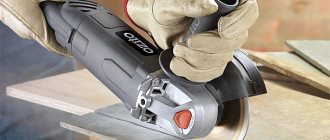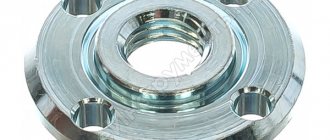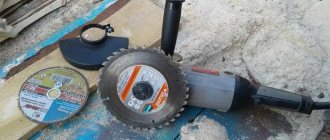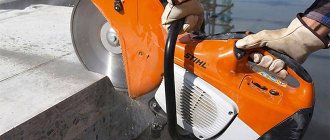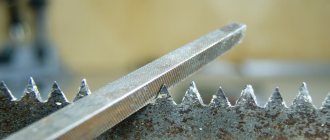An angle grinder is considered a universal tool that is used for processing materials, cutting metals, and cleaning. Depending on the scope of work, the necessary discs for the grinder are determined. The grinding wheels must match the type of material you plan to work with. Hand-held power tools are suitable for solving large-scale construction tasks and are used in everyday life.
To avoid accidents, you must adhere to safety rules when working with a grinding machine. Each tool is accompanied by instructions that define the technical features of the tool and its power indicators.
A huge selection of types of abrasive materials for cutting, grinding, finishing and stripping metal can become an obstacle to choosing the right type of disc.
Typical disk sizes for angle grinders
All interchangeable wheels have standardized sizes, so for any model of grinder you can choose a suitable size disk, even if it is “non-original” (from another company). The table below shows the typical dimensions of cutting discs in terms of thickness, diameter of the circle and seat:
| Circle diameter, mm | Thickness, mm | Mounting socket, mm |
| 115 | 1,0; 1,6; 2,0; 2,5; 3,0; 3,2 | 22,00; 22,23 |
| 125 | 0,8; 1,0; 1,25; 1,6; 2,0; 2,5; 3,0; 3,2 | 13,20; 22,23 |
| 150 | 0,8; 1,0; 1,25; 1,6; 2,0; 2,5; 3,0; 3,2 | 13,20; 22,23 |
| 180 | 1,0; 1,25; 1,6; 2,0; 2,5; 3,0; 3,2; 4,0 | 22,23; 32,00 |
| 230 | 1,6; 2,0; 2,5; 3,0; 3,2; 4,0 | 22,23; 32,00 |
The larger the diameter of the circle and its thickness, the thicker the products it can cut. Please note that the diameter of the disc should not exceed the permissible size for a particular grinder model. Thus, a 230 mm disc cannot be placed on an angle grinder with a maximum allowable wheel size of 125 mm. Such actions will force you to remove the protection, which is a violation of safety regulations, and will lead to an increase in the linear speed of the cutting edge, which is why the disk can simply fly apart during operation and injure the operator.
The diameter of the seat in most grinders is 22.23 mm, 13.20 mm is less common, and the diameter of 32.00 is relevant only for large disks. Pay attention also to the linear speed of rotation of the disk. For example, if the disc’s marking indicates a speed of 13,000 rpm, this means that your grinder must also produce such revolutions in order to work with it.
You can understand what material the nozzle can work with and what its typical dimensions are by looking at its markings on the front side. If you came to the store and picked up the disc, you can see the following:
We would like to note that sometimes the buyer may encounter non-standard nozzle sizes, and this may apply to both diameter and thickness. This often happens when purchasing “no-name” disks of unknown manufacture. We still recommend buying branded discs, since unknown ones are erased faster, and in the end you have to pay more.
Aluminum saw blade D.Bor 230mm*30\25.4mm 64 teeth (9k-412306405d)
Over the almost century-long history of its existence, the Japanese company Makita has proven itself well in the global market. Power tools, generators and garden equipment from this manufacturer are popular among professionals and amateurs who prioritize reliability, high efficiency and maximum comfort in work.
Many, out of habit developed as a result of the influx of Chinese goods of dubious quality in the 90s of the last century, are still cautiously asking sellers about the country of manufacture of this or that model of Makita power tool and, having heard the word “China”, go home with the hope of finding it. the same thing but with the “made in...” label somewhere else. And absolutely in vain. The fact is that today the Makita concern's enterprises are dispersed throughout the world - in Japan, Germany, Romania, Austria, Great Britain, America, Brazil and China. And production is distributed in such a way that certain models are produced only at specific enterprises. So in China today the production of cordless drills and screwdrivers, angle grinders, other grinders, certain models of reciprocating saws, rotary hammers, etc. has been established.
For example, it is useless to look for a Makita HR2450 hammer drill made in Germany or the UK for sale. This tool comes only from the assembly lines of one of two Chinese factories, as evidenced by the letters “Y” or “K” at the end of the serial number on the nameplate of the tool itself (the packaging and some components may be from another manufacturer).
The fact that this information is open once again confirms the transparency of Makita's economic policy and responsibility for quality. All new technologies are developed in the brand’s homeland - Japan, and improved at the Okazaki plant, and only after that, under the constant supervision of qualified specialists, they are introduced into production at other enterprises, including Chinese ones.
As for quality standards, they are the same for all Makita products, regardless of the geography of the manufacturer. All factories have certificates confirming the compliance of the existing quality management system with ISO 9000:2000 standards, aimed at satisfying the interests of consumers.
Thus, the quality of Chinese Makita, unless it is a cheap fake, is on the same level as Japanese, English or, for example, German. And to exclude counterfeiting, it is enough to use the services of an official Makita dealer. For example, the services of MakitaPro.
Cutting discs
Cutting discs are most often used when working with an angle grinder. The following nozzles are distinguished by purpose:
- For metal. Such cutting wheels are made from electrocorundum or crystalline corundum. In this case, a bakelite bond is often used inside the product. Depending on the thickness and size, the disc can cut metal profiles, stainless steel, heating pipes, etc. GRAFF GADM 115 10 is one of the representatives of inexpensive metal discs.
- For stone and concrete. Circles for cutting stone and concrete are made of silicon carbide. Please note that the disc is intended for relatively “soft” materials, such as white brick and slate (harder ones will require a diamond wheel).
- For ceramic tiles and concrete. This attachment is designed for cutting paving stones, ceramic tiles, red bricks, cutting strips for gating, etc. The disc itself is made of metal with diamond chips applied to the cutting edge. There are solid all-metal and segmented discs. The first ones are intended for wet cutting (cooling with water), as they become very hot during the process. Segmented ones are convenient for dry cutting, and they are the most popular among diamond blades. Here, for example, is a high-quality, durable segmented disk Makita B-28086 for cutting concrete and stone products.
- For wood . Discs for processing wooden structures are made of tungsten carbide or metal with abrasive coating. The first ones are designed for cutting hard and soft wood, plasterboard, gas silicate and MDF. The second one can also cut metal and even wood with nails (but this needs to be checked experimentally). Bison Professional 36859-125 is just such a representative of the “nail saw”.
- Universal. These attachments can cut almost all types of materials (for wood, it is better to take a direct-use attachment). In particular, they are convenient to use when you have to cut different materials in one working day, and you don’t want to waste time changing the nozzle. Universal models even cut reinforced concrete. However, they are often quite expensive, and sometimes it is more profitable to buy two disks for different types of materials being processed. Of the good universal circles, we can recommend Wolverine 100125, which is suitable for both wet and dry cutting.
How to calculate the consumption of a cutting disc
There are no modern centralized regulatory documents regulating the consumption of cutting wheels for metal.
Therefore, to solve this problem, you can go in two ways. The first is to use the developments of Soviet times, for example, the departmental standards of the USSR Ministry of Installation and Special Construction VSN 434. In this document, in section 5 “Method for calculating consumption rates of reinforced abrasive wheels”, you can find tables that provide standards for the number of cuts with one wheel and their consumption per shift for each standard sizes of rolled ferrous metals and pipes. The main disadvantage of this method is the problem of non-repeatability of the parameters of cutting wheels of the same type purchased by users on the modern Russian market. Therefore, it is best to adopt your own standard for each batch of purchased disks by carrying out test cutting with several of them on certain types of metal workpieces (sheet, pipe, fittings, etc.). In this way, over time, you can accumulate a sufficient database, analyze patterns and develop your own standards with correction factors.
There is often a statement that stone cutting wheels can be used to cut non-ferrous metals without any problems. What do you think about this? Please share your opinion in the comments.
Roughing
It’s worth mentioning right away that roughing and grinding discs go hand in hand, and in many stores in the “type” parameter of the attachment it may be written: “roughing grinding disc.” In our article we will divide this “couple” into two types. Peelers in this context are an attachment for freeing the structure being processed from the outer layer, for example, from rust. There are the following peeling attachments:
- Cord brushes. Cord brushes are disc or cup-shaped. Disc ones are convenient for cleaning vertical structures, for example, a tubular fence, and cup-shaped ones are used for cleaning horizontal surfaces. So cord brushes are very convenient for cleaning a car body after welding or removing rust. Here is an average-priced brass cord brush STAYER 35125-150:
- Roughing discs. Sanding discs, like cord brushes, can be flat or cup-shaped. They are intended for cleaning welds and preparing metal surfaces for grinding.
Grinding
Grinding wheels are used for polishing concrete, metal and wooden surfaces for painting or priming. Attachments for circles can be made of sandpaper, felt and even felt. In turn, the design of sanding wheels can be petal or flat (put on a wheel).
Each grinding disc has its own grit size. It is selected depending on the work being performed. Below is a table for selecting wheel grit depending on the type of grinding:
| Types of grinding | Recommended grit number |
| Flat | 16 — 36 |
| Round roughing | 24 — 36 |
| Round finishing | 60 — 100 |
| Finishing a multi-blade tool | 170 — 220 |
| Finishing | 180 — 320 |
| Thread grinding | 100 — 280 |
To summarize: how to choose a disc for an angle grinder?
To properly buy a disc for an angle grinder, you need to:
- Know the maximum size of disks that your angle grinder can handle. You cannot take disks larger than the device allows.
- Know the maximum speed of the grinder . The higher the rotation speed of the angle grinder, the smaller the disk size it can work with.
- Processed material . There are discs for wood, metal and stone. There are universal ones that can cut almost anything.
- Socket size . The size of the wheel seat must correspond to the same parameter in the angle grinder.
- Manufacturer . Do not buy frankly cheap discs or unknown products like hot cakes in the school cafeteria, and the savings will be minimal.
What types of grinder discs are there?
- Cutting discs for grinders. If you need to cut metal, cutting discs are the best option for an angle grinder. Metal cutting discs are a consumable tool used on angle grinders to cut steel, stainless steel, aluminum and other metal alloys. Grinding cutting discs for grinders are made from reinforcing fiberglass mesh, organic resins and abrasive material. For their production, heating and pressure technology is used. Depending on the type of manufacture, the cutting speed and service life of the cutting discs are determined. Aluminum oxide and zirconium dioxide are the most popular types of materials in the manufacture of grinder wheels and provide strength and good performance when cutting on steel. Cutting discs for grinders come in different thicknesses. For example, for standard everyday stainless or mild steel work, select a 1mm or 1.6mm blade thickness according to size. For working with thin metal, discs from 0.8 to 1 mm are suitable. Such thin grinder discs will quickly and efficiently cut through sheet metal. If you need to cut thicker metal, then grinding discs with a thickness of 1.6 to 2.5 mm are suitable. Thicker blades cut metal more slowly because they create more friction. Also accompanied by increased thermal output during cutting.
- Metal sanding discs are the best options for sanding welds, pipe cuts, beveling and deburring mild steel. These aluminum oxide bonded discs are most effective on mild steels. However, they are not suitable for use on stainless steel.
- Stripping STRIP discs. This is the best type of angle grinder for paint removal. These paint removal discs completely remove paint, epoxy and rust from surfaces. The surface will then be prepared for painting or coating. The discs are suitable for fast and efficient processing of surfaces that are difficult to clean.
- Folding discs are considered an excellent abrasive wheel for quickly removing burrs from welds and are suitable for grinding and stripping.
- Cleaning discs for grinders. These are also called angle grinder grinding wheels. They differ from cutting discs for grinders in thickness. It is 5 or more millimeters. Most often, such discs are for metal and stone. In work they are not intended for finishing, but are more used for rough cleaning. When exposed to metal, a large layer of material is removed. Grinder grinder discs are used for grinding a weld seam or preparing for welding work. They differ from each other in the level of graininess. If the grit value is low, these discs are suitable for coarser processing. Since burrs form after using grinder grinder discs, they need to be smoothed out using flap discs. Then the metal will be smooth and even. Grinding wheels produce a lot of sparks, so be sure to take care of protective clothing, glasses, and aprons when working. The intensity of the sparks depends on the level of grain. The principle of operation of an angle grinder with a grinding disc for an angle grinder is equated to a grinding machine. To prevent metal deformation, control the force of pressure on the tool. Coolant will also come in handy.
- Diamond discs for grinding. This is an excellent option for working with even the hardest metals. The improved formula allows the discs to be used for brick, granite, concrete, asphalt, tiles, and steel. Any material that needs to be processed or cut can be cut with a diamond blade. Previously, diamond blades were very expensive, but due to their popularity, global brands are releasing more affordable models. The relatively high cost of discs is associated with the use of diamonds. The nozzle itself is made of metal, and the cutting part is made of diamond chips. To decide on a suitable diamond blade for an angle grinder, study its technical features and determine what cutting method it is intended for - wet or dry. This determines whether you need to use coolant for the wheels.
- Polished circles for grinders. These are special discs for an angle grinder, which are made of felt or soft polymers. Their main purpose is delicate surface treatment for paint and varnish bases. If you need to carefully polish the coating, experts advise using large-diameter grinders. They operate at lower speeds and prevent damage to different types of coatings.
A grinder is a type of universal tool that will help you cope with a range of tasks. But the main thing is to use the disks for their intended purpose. Each grinder indicates the maximum permissible number of revolutions. This indicator must correspond to the grinding wheel. Remember to use safety precautions as sparks can be harmful to your health.
